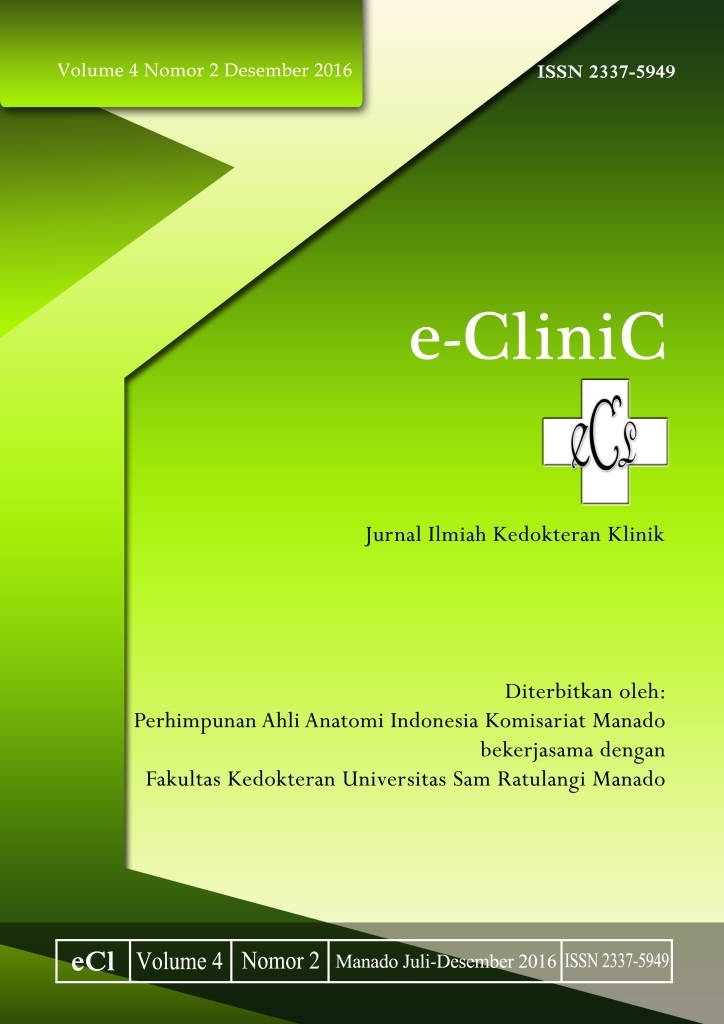Profil pasien cedera kepala sedang dan berat yang dirawat di ICU dan HCU
DOI:
https://doi.org/10.35790/ecl.v4i2.14481Abstract
Abstract: Traumatic brain injuries are still the leading cause of death and disability, and require care on Intensive Care Unit (ICU). A traumatic brain injury caused by mechanical mass from outside the body, leads to impaired cognitive and psychosocial function that can occur temporarily or permanently, and can cause loss of consciousness. This study aims to determine the profile of the patients with moderate and severe traumatic brain injuries treated in ICU and HCU, using retrospective descriptive study conducted in September to November 2016 in the Medical Record department of Prof. Dr. R.D. Kandou, Manado. The sample size was determined by non-probability sampling method, a purposive sampling. Samples are ICU and HCU patients with the diagnosis of moderate to severe traumatic brain injury, who meet the inclusion criteria in the medical record of the data period September 2015 to August 2016. From the obtained sample of 40 patients, males dominate the gender category with 33 cases (83%). SIRS complications found in 23 cases (57.5%). Most patients are treated within 1–7 days, which also become the most patients who died within their length of stay. Patients who dies account for a total of 25 patients (62.5%) and most died after > 48 hours (72%) of treatment; out of the 25 deceased patients, 18 among them (45%) died from severe traumatic brain injury. Conclusion: The mortality rate is highest on severe head injury; most patients died after > 48 hours in the ICU and the HCU.
Keywords: moderate traumatic brain injury, severe traumatic brain injury
Â
Abstrak: Cedera kepala masih merupakan penyebab utama kematian dan kecacatan, dan memerlukan perawatan Intensive Care Unit (ICU). Cedera kepala disebabkan oleh massa mekanik dari luar tubuh yang mengakibatkan gangguan fungsi kognitif dan psikososial, dapat terjadi sementara atau permanen, dan dapat menyebabkan penurunan kesadaran. Penelitian ini bertujuan untuk mengetahui profil pasien cedera kepala sedang dan berat yang dirawat pada ICU dan HCU, menggunakan metode penelitian deskriptif retrospektif yang dilakukan pada September sampai dengan November 2016 di Instalasi Rekam Medik RSUP Prof. Dr. R.D. Kandou, Manado. Besar sampel ditentukan dengan metode non probability sampling yaitu purposive sampling. Sampel penelitian adalah pasien ICU dan HCU dengan diagnosa cedera kepala sedang dan berat yang memenuhi kriteria inklusi pada data Rekam Medik periode September 2015 sampai dengan Agustus 2016. Hasil penelitian didapatkan jumlah sampel 40 pasien, dengan jenis kelamin terbanyak laki-laki 33 orang (83%). Komplikasi SIRS ditemui pada 23 kasus (57,5%). Paling banyak pasien dirawat pada 1–7 hari dan pasien yang meninggal dunia terbanyak pada lama rawat 1–7 hari. Pasien meninggal dunia berjumlah 25 orang (62,5%) dan terbanyak meninggal dunia setelah > 48 jam (72%); dari 25 orang yang meninggal dunia pasien dengan cedera kepala berat sebanyak 18 orang (45%). Simpulan: Angka mortalitas tertinggi ada pada cedera kepala berat, dan pasien meninggal dunia paling banyak setelah > 48 jam di ICU dan HCU.
Kata kunci: cedera kepala sedang, cedera kepala berat
Downloads
How to Cite
Issue
Section
License
COPYRIGHT
Authors who publish with this journal agree to the following terms:
Authors hold their copyright and grant this journal the privilege of first publication, with the work simultaneously licensed under a Creative Commons Attribution License that permits others to impart the work with an acknowledgment of the work's origin and initial publication by this journal.
Authors can enter into separate or additional contractual arrangements for the non-exclusive distribution of the journal's published version of the work (for example, post it to an institutional repository or publish it in a book), with an acknowledgment of its underlying publication in this journal.
Authors are permitted and encouraged to post their work online (for example, in institutional repositories or on their website) as it can lead to productive exchanges, as well as earlier and greater citation of the published work (See The Effect of Open Access).







